
Vernacular architecture of Russian hinterland through photographer's lens
/ Главная / Russkiy Mir Foundation / Publications / Vernacular architecture of Russian hinterland through photographer's lensVernacular architecture of Russian hinterland through photographer's lens

Photo: Fyodor Savintsev and his dog Urfin
Fyodor Savintsev is engaged in photojournalism for about 20 years. His attention recently has been drawn to Russian "dachas" - country houses that might seem to be of a dime-a-dozen type and are scattered throughout the Arkhangelsk region. This photo project was shortlisted by the World Photo contest in 2020. Fyodor shares why he's so interested in this Russian cultural phenomenon.
Fyodor introduces himself:
I am a native of Moscow, although I constantly travel from one region to another as a photojournalist and chronicle photographer. Last year, for example, I spent a lot of time in St. Petersburg. I have been shooting on a variety of topics and for many years. Currently, I refer to two last years, to be more precise, my main project is about architecture. This world used to be completely new to me, but now it has become one of my own. I call this project Six Hundreds (Originally: 6 Sotok. Russian measure "sotka" is 100 sq.m.). Within its framework, I take photos of winter houses in various horticultural non-profit associations.
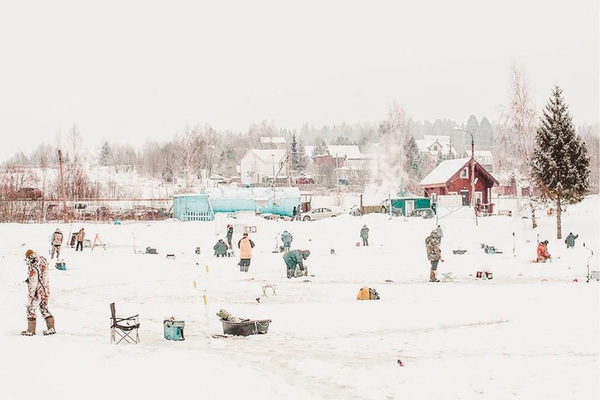
Photo Credit: Fyodor Savintsev
From Fyodor Savintsev’s Instagram notes:
How did it all start? I went on another business trip to the Northern city of Arkhangelsk and started scouting around horticultural associations in search of something unusual. And I found literally an architectural treasure there. Although ... no, it all had started even earlier! Back in 2009, in the Arkhangelsk region, I took a picture from a helicopter and made a caption for it: "Six Hundreds". It featured a horticultural non-profit association that is typical for our entire country. However, all the houses there faced one direction. Moreover, they were all of very bright colours. That picture became very popular; it was exhibited in galleries and sold in good print runs. Well, about 10 years later, I suddenly thought that it would be a great idea to figure out what kind of village it was. And that was the reason I went to Arkhangelsk.
After a long search, I finally found the place, went there and ... was stunned - there was literally a treasure trove of incredibly beautiful houses made of plywood and boards, that is, everything that had been available at hand. At the same time, they all looked incredibly holistic and harmonious. And I decided to take photos of them all in order to document, to save at least in such a manner. And then I began to shoot houses in other northern horticultural non-profit associations.
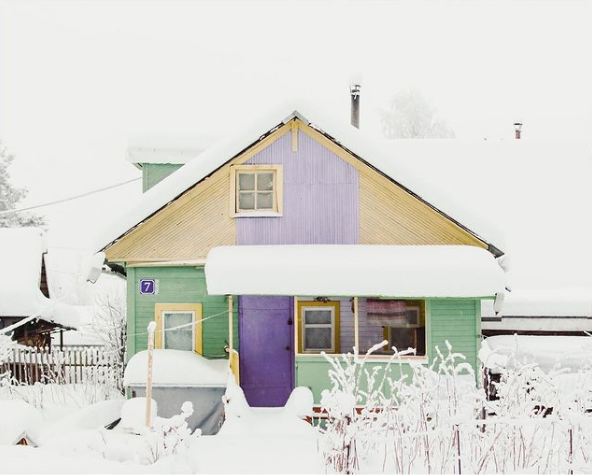
Photo credit: Fyodor Savintsev (https://www.instagram.com/p/CK8cctAhzI8/)
From Fyodor Savintsev’s notes:
The renaissance of the Aesopian language is here. So, when the owner takes care of the house, then the house, family, yard, and everything around flourishes, lives, and brings joy; but when the owner stops caring about it or the Mrs. is slattern, then insects and other pests invade the house. Thus, everything is simple - you need to take care of your home, keep it clean, and raise children implanting family values in them. Then there will be no situation with pests taking over the house. Here is a handsome looker with its "little baby". Whenever I look at this photo, everything makes me happy - colours, forms, details…
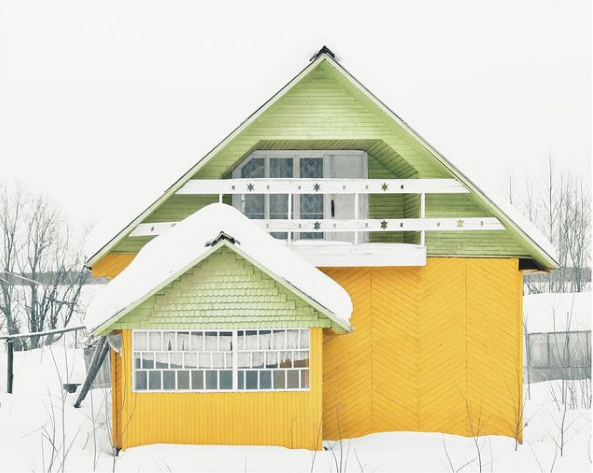
From Fyodor Savintsev’s notes:
This is a terem or a tower room made of plywood and off-cuts. Having found these blocks, I had an ear-to-ear grin. It was very much like mushroom hunting - you look around, there is something unusual on the horizon, you run-up, and everything is preserved there, all the details of that time. Trust me, there are no such houses anywhere else in the world!!!
It is quite remarkable, by the way, that all my attempts to shoot something similar in the Moscow region or in other regions have failed. No other place has such a concentration of houses that are of interest to me as the Arkhangelsk region does.
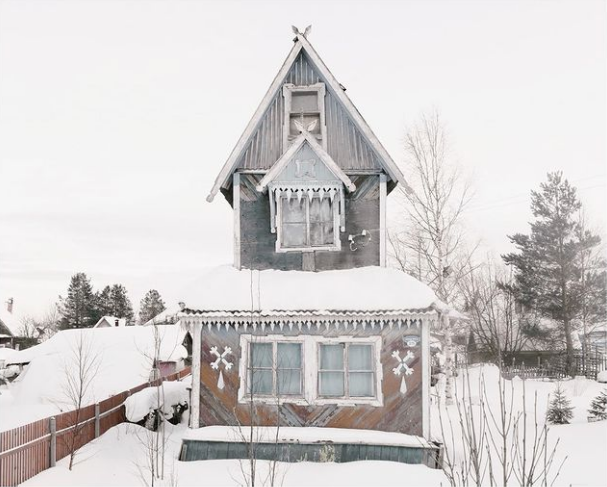
Photo credit: Fyodor Savintsev (https://www.instagram.com/p/CKrRHLNhuEx/)
From Fyodor Savintsev’s notes:
It was inner freedom, erudition, and culture that enabled people of that time to create such things. These are children's drawings made flesh. I believe, it is important to note that those tiny plots were situated literary on swamps, and the building of any house required arrangement of drainage works, digging ditching, etc.
And so people used to come here after work, or at weekends. They cultivated the land, and only then, back in their apartments, they thought of ideas for their little darlings. Do you understand? The starry sky !!! Ships! Polar Star!” No, it was not everywhere that beautiful houses could be found. But the found ones were sometimes true masterpieces and monuments of the era. What was the reason behind that? I think that since people did not have the money to rebuild their houses or to sheathe them with siding, they used things available at hand.
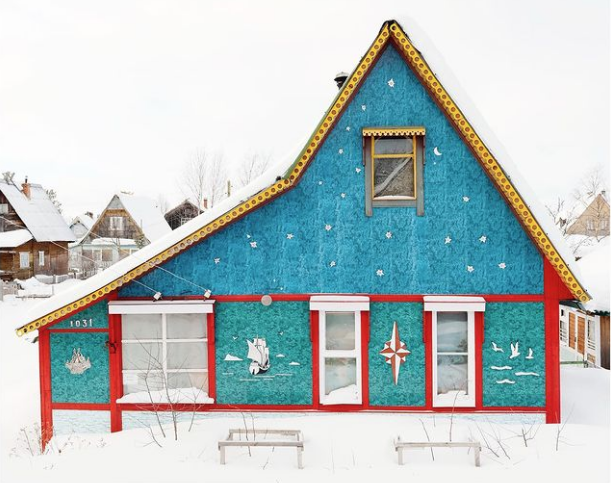
From Fyodor Savintsev’s notes:
These houses are like children's drawings for me - pure fantasy. You need to understand that this will not happen again. A couple of posts ago someone wrote to me that now it was the time of utilitarian minimalism. But I wonder why it is absolutely not interesting to walk and look at modern architectural masterpieces of country houses. When I talked with the owners of those little "fruit drops", one elderly man told me that he had walked around the settlement and looked at constructions in progress, so he wanted to create something just as beautiful. There was a desire and urge for creativity.
I post my own photos on my Instagram account page quite rarely. Thus, many of my followers believe that I am an elderly person, or why would I be interested in such architecture otherwise? But I am not. I am 38 years old. And it is not nostalgia that is behind my love for country houses. They attract me in terms of visual aesthetics only, which, actually, does trigger nostalgia. They are connected to our country’s history to one degree or another, just as the Soviet dachas do, although their aesthetics is completely different. They are a kind of intelligentsia’s exquisite paradise that has become the hero of my other project.

From Fyodor Savintsev’s notes:
“Here is another green one. Among hundreds of houses, wrapped in modern excuses, such "guys" are noticeable very well, they stand on their own, live out their days, but they live out proudly. I upload stories to show that any house can be made featureless, but I also give hints on how people can personalize their homes. The challenge today is not even about lots of money that are required for construction but about the lack of those who are capable of building. True craftsmen are not available anymore, and skillful crews are much in demand. Nevertheless, if there is a desire, everything can be implemented; you just need to have a clear image of what you want.”
I always try to communicate with the owners, get inside their houses, and learn their story. But people, of course, respond differently, especially now, at a time of general stance of distance. It is somehow easier with Soviet dachas. But when it comes to garden houses in the Arkhangelsk region, the situation is complicated by the fact that in winter they are empty, as if frozen. And there is snow all around, literally up to the waist, or even higher. And I wear special snowshoes to walk on it.
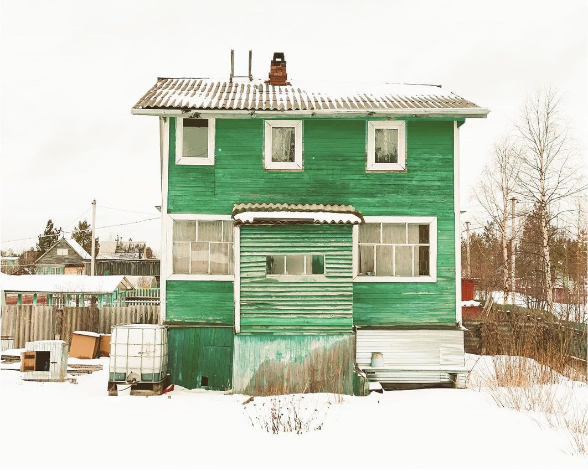
Photo credit: Fyodor Savintsev (https://www.instagram.com/p/B91FGRrhBEp/)
From Fyodor Savintsev’s notes:
All this beauty was built from the ground up, on the swamps. People themselves drained the plots, brought land in, fortified it, and then built their houses. It was difficult to get construction materials. The foundation was mainly made of sleepers, the sheathing was made of sawmill waste. If people could get something, they did it, and then built houses. So far, I'm just on the way to understanding where people got such colors for painting facades. Someone says that the paint was procured from the navy. But so far the information is unconfirmed.
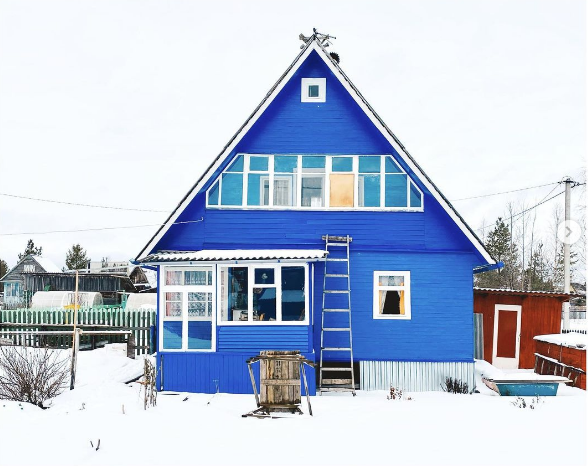
Photo credit: Fyodor Savintsev (https://www.instagram.com/p/B93QDYPh-2P/)
And yet another thing: people in Northern horticultural settlements simply do not understand what they own! Therefore, every year all these houses of theirs disappear, one by one. They disappear due to the invasion of cheap construction materials... So my project is about the statement: “Look around and you will see how people used to create beauty despite the absence of proper materials. And now, with so many greater opportunities, it looks that we have lost our appreciation! " It seems to me that these horticultural non-profit associations should host sightseeing tours. While the owners see their belongings as a shed, junk that needs to be covered up with siding.
Original article by: Lenta.ru
New publications

 Mikhail Kalatozov, a director who transformed the world of cinematography in many ways, was born 120 years ago. He was a Soviet film official and a propagandist. Above all, he was capable of producing movies that struck viewers with their power and poetic language.
Mikhail Kalatozov, a director who transformed the world of cinematography in many ways, was born 120 years ago. He was a Soviet film official and a propagandist. Above all, he was capable of producing movies that struck viewers with their power and poetic language.  Ukrainian authorities have launched a persecution campaign against the canonical Ukrainian Orthodox Church (UOC), the biggest one in the country's modern history. Over the past year, state sanctions were imposed on clergy representatives, searches were conducted in churches, clergymen were arrested, criminal cases were initiated, the activity of the UOC was banned in various regions of the country, and monasteries and churches were seized.
Ukrainian authorities have launched a persecution campaign against the canonical Ukrainian Orthodox Church (UOC), the biggest one in the country's modern history. Over the past year, state sanctions were imposed on clergy representatives, searches were conducted in churches, clergymen were arrested, criminal cases were initiated, the activity of the UOC was banned in various regions of the country, and monasteries and churches were seized.  When Nektary Kotlyaroff, a fourth-generation Russian Australian and founder of the Russian Orthodox Choir in Sydney, first visited Russia, the first person he spoke to was a cab driver at the airport. Having heard that Nektariy's ancestors left Russia more than 100 years ago, the driver was astonished, "How come you haven't forgotten the Russian language?" Nektary Kotlyaroff repeated his answer in an interview with the Russkiy Mir. His affinity to the Orthodox Church (many of his ancestors and relatives were priests) and the traditions of a large Russian family brought from Russia helped him to preserve the Russian language.
When Nektary Kotlyaroff, a fourth-generation Russian Australian and founder of the Russian Orthodox Choir in Sydney, first visited Russia, the first person he spoke to was a cab driver at the airport. Having heard that Nektariy's ancestors left Russia more than 100 years ago, the driver was astonished, "How come you haven't forgotten the Russian language?" Nektary Kotlyaroff repeated his answer in an interview with the Russkiy Mir. His affinity to the Orthodox Church (many of his ancestors and relatives were priests) and the traditions of a large Russian family brought from Russia helped him to preserve the Russian language.

 The leaders of the Friends of the Great Russia cultural association (Amici Della Grande Russia) in Italy believe that the Western policy of abolishing Russian culture in Europe has finally failed. Furthermore, it was doomed to failure from the beginning.
The leaders of the Friends of the Great Russia cultural association (Amici Della Grande Russia) in Italy believe that the Western policy of abolishing Russian culture in Europe has finally failed. Furthermore, it was doomed to failure from the beginning.  Name of Vladimir Nemirovich-Danchenko is inscribed in the history of Russian theater along with Konstantin Stanislavski, the other founding father of the Moscow Art Theater. Nevertheless, Mr. Nemirovich-Danchenko was a renowned writer, playwright, and theater teacher even before their famous meeting in the Slavic Bazaar restaurant. Furthermore, it was Mr. Nemirovich-Danchenko who came up with the idea of establishing a new "people's" theater believing that the theater could become a "department of public education."
Name of Vladimir Nemirovich-Danchenko is inscribed in the history of Russian theater along with Konstantin Stanislavski, the other founding father of the Moscow Art Theater. Nevertheless, Mr. Nemirovich-Danchenko was a renowned writer, playwright, and theater teacher even before their famous meeting in the Slavic Bazaar restaurant. Furthermore, it was Mr. Nemirovich-Danchenko who came up with the idea of establishing a new "people's" theater believing that the theater could become a "department of public education."  "Russia is a thing of which the intellect cannot conceive..." by Fyodor Tyutchev are famous among Russians at least. December marks the 220th anniversary of the poet's birth. Yet, he never considered poetry to be his life's mission and was preoccupied with matters of a global scale. Mr.Tyutchev fought his war focusing on relations between Russia and the West, the origins of mutual misunderstanding, and the origins of Russophobia. When you read his works today, it feels as though he saw things coming in a crystal ball...
"Russia is a thing of which the intellect cannot conceive..." by Fyodor Tyutchev are famous among Russians at least. December marks the 220th anniversary of the poet's birth. Yet, he never considered poetry to be his life's mission and was preoccupied with matters of a global scale. Mr.Tyutchev fought his war focusing on relations between Russia and the West, the origins of mutual misunderstanding, and the origins of Russophobia. When you read his works today, it feels as though he saw things coming in a crystal ball...